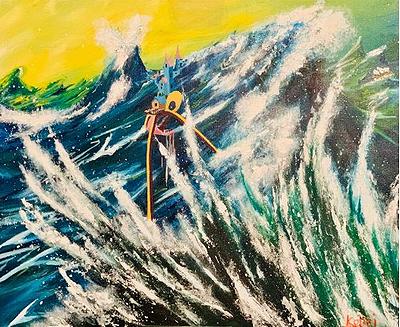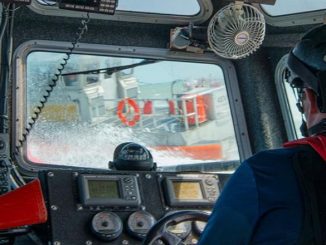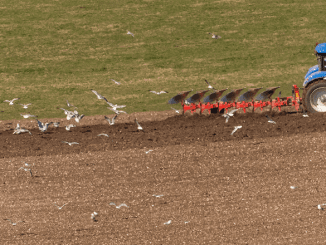
NEW YORK, New York, June 8, 2020 (ENS) – The World Oceans Day Theme for 2020 is “Innovation for a Sustainable Ocean,” but the coronavirus pandemic is top-of-mind today as the world focuses on the health of the oceans.
“Oceans and fishing have been dramatically impacted by the coronavirus pandemic,” Andy Sharpless blogged today to mark World Oceans Day 2020. The CEO of the U.S. nonprofit group Oceana, Sharpless offers new data from Global Fishing Watch, an organization that Oceana co-founded, showing that global commercial fishing activity through April was down 6.5 percent.

“Large-scale fishing nations, like those in the European Union, experienced a dramatic reduction in weekly fishing activity of 50 percent or more,” he said.
Both GFW and the UN Food and Agriculture Organization, FAO, assessed the impact of COVID-19 on fisheries and aquaculture and found small-scale fishers have likely been some of the hardest hit in the fishing community.
With fish markets closed around the world, small-scale and artisanal fishers have nowhere to sell their catch, Sharpless explained.
Still, the global, multi-billion-dollar-a-year illicit fishing industry persists and has even been thriving during the pandemic.
FAO says 87 percent of those surveyed in the fishing community with roles in monitoring, control, and surveillance report that the impact of COVID-19 is having, or is expected to have negative consequences on the fight against illegal, unreported, and unregulated (IUU) fishing.
“This impact is apparent in the Philippines, where illegal fishing has long been an issue,” wrote Sharpless.
Now, due to a lack of enforcement and observer coverage because of the coronavirus, illegal fishing is on the rise, especially in the Philippines, where the reduced patrols due to the coronavirus lockdown gave IUU fishers an opening to harvest areas usually closed to them, satellite tracking data indicate.
Oceana Philippines created a group called Karagatan Patrol, a platform for citizens to report illegal fishing in municipal waters in coordination with law enforcement. Karagatan Patrol tracks ships through the visible infrared imaging radiometer suite, VIIRS, a satellite-based tool that detects the high-radiance lure lights used by commercial fishing vessels.
In a single week in May, the Karagatan Patrol reported a 154 percent increase of boats operating illegally in Philippine municipal waters.
“The excuse of commercial fishing operators found plying on the municipal water is that they are hiding from high waves,” Gloria Estenzo Ramos, Oceana vice president and head of its Philippines office, told the news outlet Mongabay. “In reality, they go fishing in bays and gulfs that are critical marine habitats that will destroy spawning grounds of young fishes.”
“This year, however, the unprecedented challenges with COVID-19 have demonstrated the need to adapt, build resilient systems, and, above all, cooperate internationally. There’s a lesson here for the fight against IUU fishing: When there is great need, political will – and, with it, potential change – can build quickly,” said Ramos.

Six out of the 10 largest fisheries in the world are in Asia – China, Indonesia, India, Japan, Vietnam, and the Philippines – and 34 million people in the Asia-Pacific region are engaged in commercial fishing, according to the Asian Development Bank.
But the region’s ocean ecosystems “have been pushed to the brink of collapse,” the Bank says in its 2019 plan for healthy oceans. “Half of all coral reefs have disappeared, fish stocks and marine species are in decline, the ocean is getting warmer and more acidic, and sea levels are rising. If fish stocks continue to deteriorate as predicted, the implications could be catastrophic for millions of people who depend on fisheries for food and livelihood to survive,” the Bank warned.
There are also consequences around the world that flow from the fact that research, assessments, and observer coverage is being delayed or abandoned because of the pandemic.
In Alaska, the U.S. National Oceanic and Atmospheric Administration, NOAA, has officially canceled nearly all their fish surveys this season. This loss of data causes a ripple effect on estimates of fish abundance, stock assessments, and quotas. Fisheries management decisions made on incomplete data are less effective and can impact ocean abundance for years to come.
NOAA scientists are forecasting this summer’s Gulf of Mexico hypoxic area or “dead zone,” an area of low to no oxygen that can kill fish and other marine life, to be roughly 6,700 square miles, larger than the long-term average measured size of 5,387 square miles but less than the record of 8,776 square miles set in 2017. The annual prediction is based on U.S. Geological Survey river-flow and nutrient data.
The annual summer Gulf of Mexico dead zone is caused by excess nutrient pollution from human activities throughout the Mississippi River watershed. When the excess nutrients reach the Gulf, they stimulate an overgrowth of algae, which die and decompose, depleting oxygen as they sink to the bottom.
The resulting low oxygen levels near the bottom of the Gulf cannot support most marine life. Fish, shrimp and crabs often swim out of the area, but animals that are unable to swim or move away are stressed or killed by the low oxygen.
“Not only does the dead zone hurt marine life, but it also harms commercial and recreational fisheries and the communities they support,” said Nicole LeBoeuf, acting director of NOAA’s National Ocean Service. “The annual dead zone makes large areas unavailable for species that depend on them for their survival and places continued strain on the region’s living resources and coastal economies.”

It’s not only coastal communities that are suffering the effects of the changing oceans – suffering continues on the high seas.
Luis Javier Sandoval of the Pew Charitable Trusts wrote in March, “The high seas are distant and vast, starting 200 nautical miles from the shoreline and making up nearly two-thirds of the ocean. These waters don’t get the attention of closer-to-shore ecosystems, but they should. The high seas are teeming with life and support important and unique ecosystems. Now, however, all of that is under increasing threat from human activities and climate change, which is making the ocean warmer and more acidic.”
“Marine protected areas, MPAs, are among the most effective tools for conserving and restoring ocean health, according to a growing body of science, but under the current system of ocean management, there is no way to establish comprehensive MPAs for most parts of the high seas,” Sandoval writes on the Pew Trusts website.
A United Nations treaty on marine biological diversity of areas beyond national jurisdiction aims to address this gap by enabling, among other things, the creation of high seas MPAs. UN negotiations on that agreement are scheduled to conclude this year.
Meanwhile, the UN is speaking out to raise public awareness of what the immediate threat of the pandemic is doing to the oceans and those who depend on them.
The COVID-19 pandemic is a “sharp reminder” of how we are all intimately connected to each other and to nature, the UN chief said today to mark World Oceans Day.
“As we work to end the pandemic and build back better, we have a once-in-a-generation opportunity, and responsibility, to correct our relationship with the natural world, including the world’s seas and oceans,” Secretary-General António Guterres said in his World Oceans Day message to the world.

Recognizing that, “We rely on the oceans for food, livelihoods, transport and trade,” Guterres explained that, “as the lungs of our planet and its largest carbon sink, they also play a vital role in regulating the global climate.”
“Today, sea levels are rising due to climate change, threatening lives and livelihoods in low-lying nations and coastal cities and communities around the world,” Guterres warned.
Moreover, as the oceans are becoming increasingly acidic, marine biodiversity and essential food chains are increasingly being jeopardized. And plastic pollution has become ubiquitous.
Against this backdrop, Innovation for a Sustainable Ocean has been chosen as this year’s theme for World Oceans Day.
Better understanding of the oceans is essential for conserving fish stocks and discovering new products and medicines.
“The upcoming United Nations Decade of Ocean Science for Sustainable Development will provide impetus and a common framework for action,” the UN chief said, urging governments and all concerned to commit innovation and science to conserve and sustain the world’s oceans.
President of the UN General Assembly Tijjani Muhammad-Bande warned that the unsustainable misuse of this valuable resource threatens “the ability of our oceans to provide for us.”
As we look towards the Decade of Ocean Science for Sustainable Development, which will begin next year, Muhammad-Bande encouraged everyone to “take urgent action” by putting protection measures into motion to enable the oceans to create a better world on land and underwater, “for generations to come.”
A healthy marine environment holds the potential for achieving the entirety of the Sustainable Development Agenda, the UN officials emphasized.
In January, the Decade of Action and Delivery opened to implement the Sustainable Development Goals (SDGs). “Protection of marine biodiversity is of essential importance as we progress with the implementation of SDG14,” Mohammad-Bande said, referring to the 14th global goal, to conserve and sustainably use the oceans, seas and marine resources for sustainable development.
“This World Oceans Day, we must take a moment to reflect on and appreciate all that the ocean does for us. It is also an opportunity for us to look forward,” he pointed out, asking everyone to “harness the potential of blue and green economies. This year we must take action to prevent a further eight million tons of plastic waste from entering the ocean and protect global ecosystems.”
In closing, Mohammad-Bande urged all UN Member States to “commit to protecting 30 percent of our blue planet by 2030,” in order to safeguard at least 30 percent of the oceans, through a network of highly protected areas. He pleaded for action, saying, “We simply cannot stand by while oceans acidify, sea levels rise and pollution increases.”
World Oceans Day doesn’t end at midnight tonight, it has inspired events throughout 2020. To find out about World Ocean Day events taking place around the world from now through the end of the year, visit: https://unworldoceansday.org/events-map
Copyright Environment News Service (ENS) 2020. All rights reserved.
© 2020, Environment News Service. All rights reserved. Content may be quoted only with proper attribution and a direct link to the original article. Full reproduction is prohibited.



